

Schemas in Children’s Play. Written by Clare CaroSchemas in Children’s Play are such an important concept when it comes to the development of our children that it’s worth taking the time to understand them so you can facilitate them when you see them.What are these schemas?

Well it’s really a fancy word for the urges that children have to do things like climb, throw things and hide in small places. They appear through play; perhaps it is the way they choose to do things, or what they desperately need to do out of the blue! Bringing It All TogetherAfter looking at each schema individually to get to grips with what each 'urge' is all about we may already be able to recognise some of the different ways they can appear in your child.Rotation, Trajectory, Enveloping, Orientation, Positioning, Connection, Enclosure/Container, Transporting and Transformation are urges that show in all children starting as early as their first birthday, some times before.How Can Knowing About These Urges Help Us?
Sustainability - Natural Resources SA Northern and Yorke. Creating a culture of sustainability is important to our community and our schools.
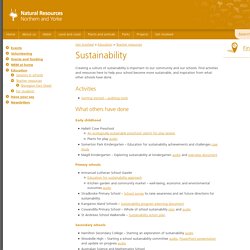
Find activities and resources here to help your school become more sustainable, and inspiration from what other schools have done. Activities Getting started – auditing tools. Grow me safely. Kidsafe NSW was the winner of the 2014 Nursery & Garden Industry Awards - Industry Innovation Award category for the ‘grow me safely’ website resource!
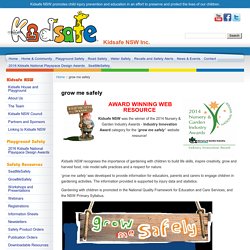
Kidsafe NSW recognises the importance of gardening with children to build life skills, inspire creativity, grow and harvest food, role model safe practices and a respect for nature. ‘grow me safely’ was developed to provide information for educators, parents and carers to engage children in gardening activities. The information provided is supported by injury data and statistics. GMGC ResourceKit V2. Inspiring Children's Spirit of Stewardship: A Toolkit for Early Childhood Programs. Nature play week. Why Nature Play?

Do you remember your favourite childhood place in nature? Where was it? How did you find it? How did you feel when you were there? Over the past 30 years, we have moved indoors and screen spaces have replaced green places. This change in the experience of and exposure to nature has led to a gradual distancing between our kids and the natural world and has profound implications for the mental, physical, emotional and spiritual health of future generations – and for the health of nature itself. A growing body of evidence suggests that, from backyards to streets, parks and gardens, from the beach to the bush, kids do better outside! Nature play is a term used to describe the creation of simple play opportunities in the natural environment. Getting your kids involved in Nature Play doesn’t have to be expensive or time-consuming, it can be as simple as a visit to the local park where the kids can roam free.
Nature plays a big role in childhood happiness - ABC WA. The benefits of outdoor learning and outdoor activities for children. Planet Ark. Planet ark calendar schools. Getting the Balance Right - our new Guide for Risk Management. Seed Harvest Spoon - Educating children in sustainability practices for our Environment.
UCG Eco Resource Kit 2013 web version. How to series create the perfect play space f. List of useful existing resources 5.pdf. Keep It Simple Niki Willows (2) Early Childhood Programs for Chemical Free Children. Sustainable Childcare Resources. Outdoor_Play_Ros_Patterson. Growing Minds Greening Communities. Patchesofgreen. InspirationsforOutdoorSpaces_LGSWA.pdf. Water factsheet.pdf. Seed Harvest Spoon - Educating children in sustainability practices for our Environment. World Forum Foundation. Sustainability in Children's Services : Children's Services.
Green Earth by digitalart © Teacher, DET NSW 2012 SWSi Libraries have created a new LibGuide on Sustainability.

The Websites by Industry tab highlights three useful resources for children's services. Or visit the Sustainability LibGuide and browse the hand picked collection of links to websites, online videos, and other on-shelf resources. Don't forget professional journals are a high quality source when researching a topic. You can search the online journals by selecting Databases from the SWSi Libraries webpage. Or borrow the Volume 13, No. 1, 2007 issue of Every Child magazine. The TAFE catalogue lists other useful sustainability resources. Home. Rethinking Childhood. Backyard in a box. Adventure Activity Standards. Sustainability resources - NSW Department of Education & Communities. Quality Area 3 of the National Quality Standard focuses on the physical environment, assessing that it is safe, suitable and provides a rich and diverse range of experiences that promote children's learning and development, and children becoming environmentally aware and responsible.
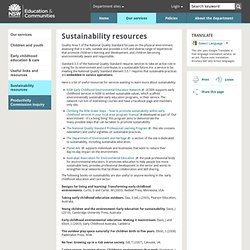
Standard 3.3 of the National Quality Standard requires services to take an active role in caring for its environment and contributes to a sustainable future. For a service to be meeting the National Quality Standard element 3.3.1 requires that sustainable practices are embedded in service operations. Reconnecting Victorian Kids to Nature. Discussions of play and playgrounds. Poisonous plants. Disclaimer: This fact sheet is for education purposes only.

Please consult with your doctor or other health professional to make sure this information is right for your child. Lots of plants are poisonous or capable of causing highly allergic reactions. Some will also pierce you with their sharp spines. PlaygroundIDEAS - Building playgrounds and helping others do the same. Australian Association for Environmental Education. What is education for sustainability? / EfS in the curriculum / Home - Education for Sustainability.
Education for sustainability is about learning to think and act in ways that will safeguard the future wellbeing of people and our planet.

What will my students do in education for sustainability? Early Childhood SIG « Australian Association for Environmental Education. About this Group The EC SIG was established in 2003 by AAEE to recognise an emerging group of early childhood professionals working across the early childhood sector to promote education for sustainability.
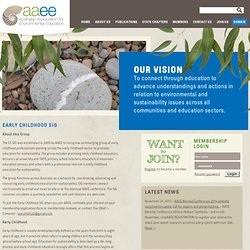
The group includes practising early childhood educators, lecturers at university and TAFE, primary school teachers, educators in extension education services and others with a professional interest in early childhood education for sustainability. The group functions across Australia as a network for coordinating, advocating and resourcing early childhood education for sustainability. SIG members connect electronically by email and meet locally or at the biannual AAEE conference. The SIG convenor circulates a quarterly newsletter and contributions are welcome.
To join the Early Childhood SIG when you join AAEE, nominate your interest on your membership application form or membership renewal, or contact Sue Elliott – Convenor -sue.elliott22@gmail.com. Affordable settings and elements. The Sustainability Hub - Connecting Sustainable Schools and Communities. Perfect_play_spaceWEBv2. Sustainability at Ainslie Parklands Primary School (formerly Croydon West P.S.)
Home - Healthy Spaces & Places. Download: for all practitioners and decision makers who are working within the built and natural environment, who can help tackle some of Australia’s major preventable health issues by – walking, cycling and using public transport – every day.
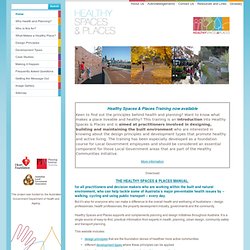
But it’s also for everyone who can make a difference to the overall health and wellbeing of Australians – design professionals, health professionals, the property development industry, governments and the community. Healthy Spaces and Places supports and complements planning and design initiatives throughout Australia. It is a single source of easy-to-find, practical information from experts in health, planning, urban design, community safety and transport planning. This website includes: FromPolicingTo-CA-Wien.
ClimbLittleGreenSteps. Checklists. Let the children play. Kids’ & Baby Play Mats for Kindergartens & Childcare by EcoViva. Quality_Area_3_A4. 88cec2_18c7e5eed49942a695cf9ef15de854ce. Environmental Education in Early Childhood - Victoria - Home Page. AAEEWA - Australian Association for Environmental Education Western Australia. Irresistible Ideas for play based learning. Frameworks Recycled Materials for Arts and Crafts. Early Learning Incursions - The Sustainability Hub. CERES Early Learning Incursions are designed specifically for younger children, with the aim to introduce them to environmental issues in a fun, interactive environment.
Our Early Learning Incursions have been developed in conjunction with Environmental Education in Early Childhood (EEEC) and delivered in partnership with Learning Happens (consultants in early childhood and children’s services). Programs are run with props, costumes, books and songs. Early childhood educators/teachers are provided with extensive post-visit resources and information to be taken home to families. Wonderful Worms Introduces students to worms and the role they play in organic recycling.Explores some worm characteristics, their habitat and what they eat.CERES brings along our very own miniature worm farm so everyone can hold a worm. Water Cyclists Introduces students to the water cycle using a colourful set of costumes and props.Explores how water is used and why it is such a precious resource.
Not Just Veggies.